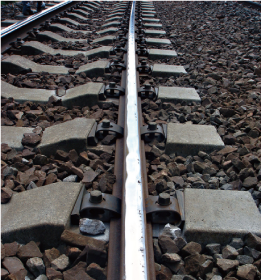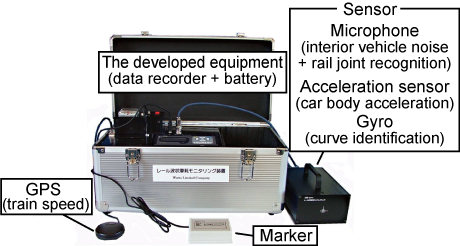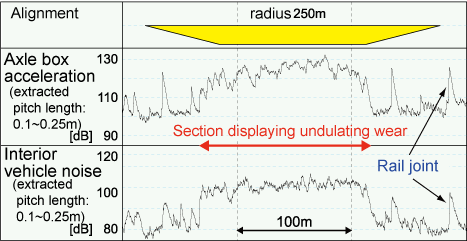5. Portable rail-corrugation monitoring equipment
- Portable equipment was designed, allowing simple measurement of rail corrugation, from on board the train.
- By placing the present equipment on the floor of a vehicle to record sound, it is possible to locate and determine the level of rail corrugation.
Rail corrugation on the tread surface of the rail (Fig1) can be the cause of wayside noise and track deterioration. Regular monitoring and rail grinding are therefore important. Methods used today to monitor corrugation include visual inspection or utilizing axle box acceleration. Visual inspection however, is very labour-intensive. Furthermore, using axle box acceleration for measurement first requires work to be carried out on the accelerometer installed on the axle box. In addition, the measurement schedule is influenced by train operations.
To meet the abovementioned demands, portable rail corrugation monitoring equipment was therefore developed, which does not require any under body work since it can make the necessary measurements easily, from on board the vehicle (Fig 2).
The present equipment consists of a sensor situated onboard, on the vehicle floor. When the fixed frequency of noise inside the vehicle exceeds the threshold value, this is interpreted as a corrugated section, and the magnitude of the wear is estimated. Furthermore, since this equipment uses speed (with GPS), curve (with Gyro) and rail joint data, it can convert the measured acceleration as a function of distance and accurately localise the corrugated section.
The outcome of trials utilizing a prototype on a conventional line with an actual vehicle demonstrated its capacity to extract the rail corrugation wavelength, combined with vehicle noise in the cabin, to identify the corrugated sections with almost the same accuracy as axle acceleration measurements (Fig 3).
The present work also showed a strong correlation between corrugation wave peaks and noise levels in the cabin. The aforementioned results prove that this equipment possesses the necessary functionalities to serve as a rail corrugation monitoring tool.
Given that the system relies on interior vehicle noise, it is recommended that measurements utilizing this equipment be made from onboard trailed vehicles rather than power cars.
 Fig. 1 Rail corrugation on the surface
Fig. 1 Rail corrugation on the surface Fig. 2 Portable monitoring equipment
Fig. 2 Portable monitoring equipment Fig. 3 Example of rail corrugation identified on a section of track
Fig. 3 Example of rail corrugation identified on a section of track